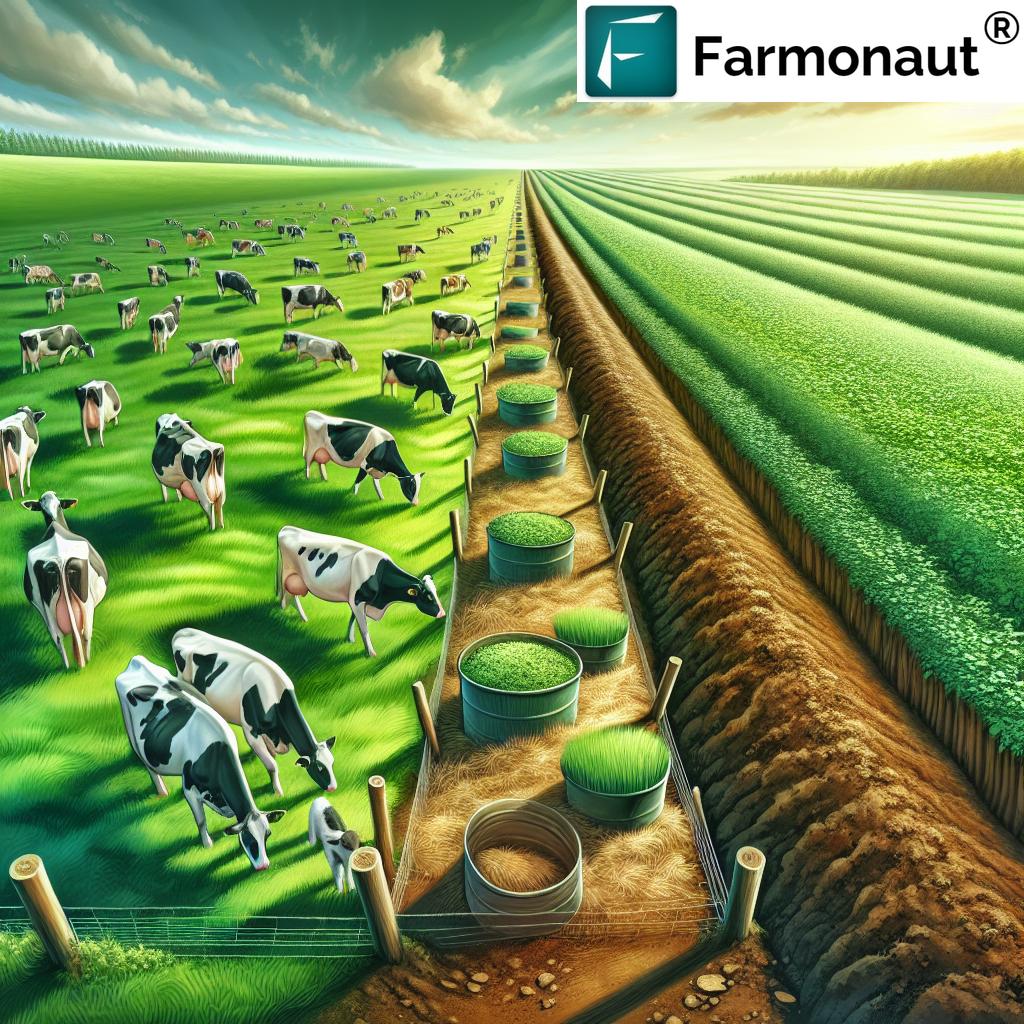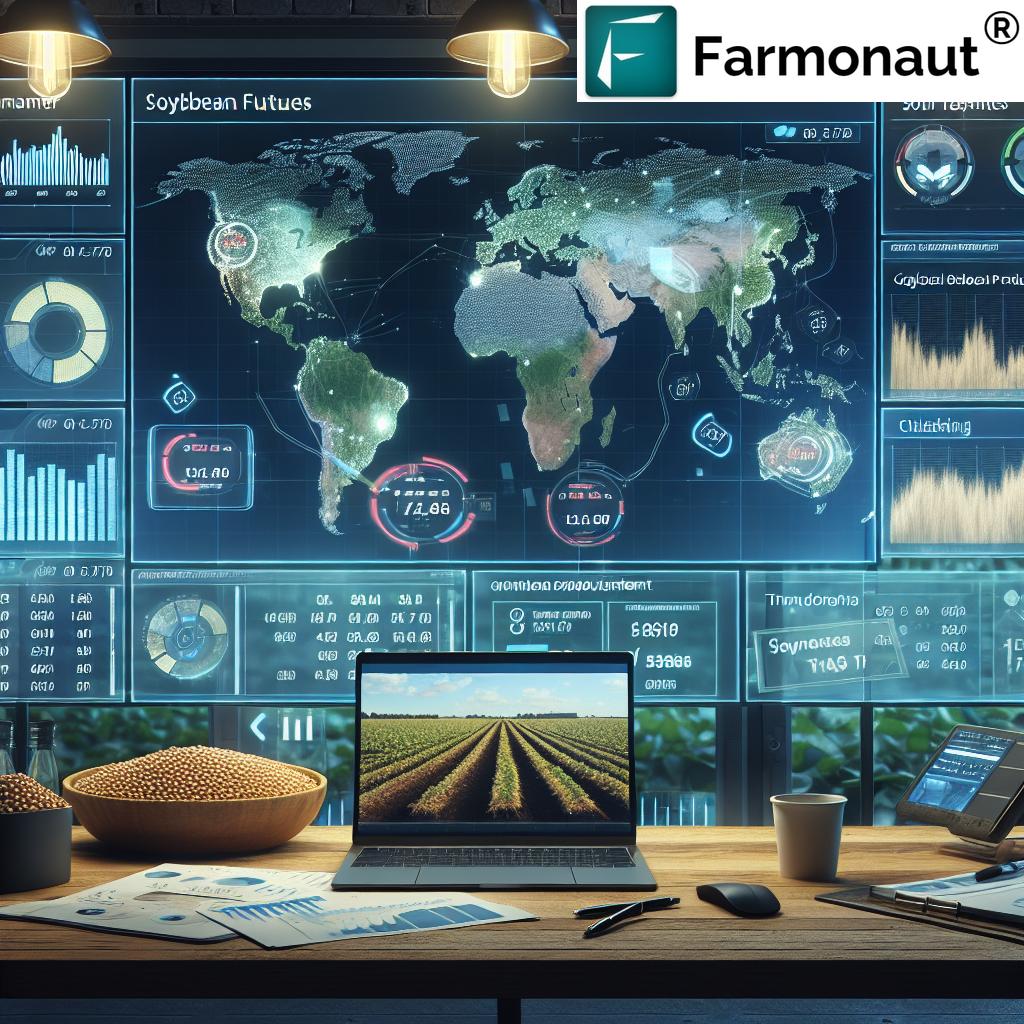Agriculture Emissions: Large Greenhouse CO2 Reduction – The Role of Large Greenhouses in Sustainable Farming (2025 & Beyond)
“Large greenhouses can cut agricultural CO2 emissions by up to 40% compared to traditional open-field farming in 2025.”
Table of Contents
- Understanding Agricultural Greenhouse Gas Emissions (2025 Update)
- Major Sources of Agricultural GHGs: CO2, Methane, and Nitrous Oxide
- Why Large Greenhouses? A Critical Path to Reducing Agriculture CO2 Emissions
- Comparative Impact Table: Open-Field vs. Large Greenhouse (2025)
- Key Advantages of Building a Large Greenhouse
- Enabling Sustainable Agriculture through Controlled Environment
- Integrated Renewable Energy: Solar Panels and Geothermal Solutions
- Water Use Optimization and Resource Efficiency
- Advanced GHG Monitoring and Management with Satellite Systems
- Farmonaut: Satellite-Driven Sustainability for Agriculture
- Investment & Economic Case for Large Greenhouses
- Future Trends: Scaling Large Greenhouses for Global Food Security
- FAQ: Agricultural Emissions & Large Greenhouse Solutions in 2025
- Farmonaut Subscriptions & Resources
- Conclusion: Charting a New Course for Sustainable Agriculture (2025+)
Understanding Agricultural Greenhouse Gas Emissions (2025 Update)
Agricultural greenhouse gas emissions remain a significant contributor to accelerated climate change and are a critical focus in the quest for a sustainable food future. As of 2025, agriculture accounts for roughly 20–25% of total global anthropogenic emissions, including carbon dioxide (CO2), methane (CH4), and nitrous oxide (N2O). Understanding these emission sources is paramount for mitigating risk and achieving international climate goals—especially as the pressure for food security, environmental protection, and efficient resource use grows globally.
From rice paddies and livestock digestion to intensive fertilizer use and large-scale farm operations, agriculture’s management practices directly influence atmospheric CO2 and other GHG concentrations.
As 2025 unfolds, the urgent need to reduce agricultural greenhouse gas emissions is clearer than ever: major advancements—like building large greenhouses—can reshape agricultural resource efficiency and ecological impact.
Major Sources of Agricultural GHGs: CO2, Methane, and Nitrous Oxide
Let’s break down the most critical emission sources in modern agriculture:
- CO2 Emissions: Primarily from fossil fuel use in machinery and heating, deforestation for farm expansion, and soil carbon loss due to aggressive tillage and land conversion. Although CO2 is less potent per molecule than other GHGs, its sheer volume makes it the top target in reduction strategies.
- Methane (CH4): Results primarily from livestock digestion (enteric fermentation), manure management, and rice paddies (anaerobic decomposition in flooded fields).
- Nitrous Oxide (N2O): Comes from soil management practices, especially excessive fertilizer application and inefficient waste handling. N2O is over 300x more potent than CO2 over a 100-year period.
The collective impact of these emissions is not only environmental, but also economic and social. Tackling them is essential for making the sector resilient, sustainable, and productive.
Why Large Greenhouses? A Critical Path to Reducing Agriculture CO2 Emissions
With mounting population and environmental pressures, large greenhouses are rapidly gaining traction in 2025 as a practical, science-backed solution for mitigating agricultural greenhouse gas emissions. These climate-controlled structures fundamentally change the game for resource optimization, CO2 reduction, and yield improvement.
- Reduced Land Footprint: Greenhouses enable intensive, vertical farming on smaller plots, preserving natural carbon sinks and minimizing deforestation.
- Efficient Environment Control: Automated management of temperature, humidity, and CO2 levels leads to optimized plant growth and reduced resource waste.
- Minimized Methane & N2O: Greenhouses largely avoid practices like flooded rice paddies and excessive fertilizer use, sharply cutting methane and nitrous oxide output.
- Integrated Energy Solutions: Adoption of solar panels, geothermal systems, and CO2 recycling tech significantly curtails fossil fuel reliance and lowers direct emissions.
- Water Conservation: Advanced, closed-loop irrigation systems optimize water use, contribute to further emission reduction, and protect ecosystem health.
Large greenhouse adoption is a powerful strategy for both CO2 reduction and increased agricultural sustainability in 2025—and is now accessible at scale with digital monitoring and integrated energy solutions.
“Greenhouse farming increases resource efficiency, using up to 90% less water while boosting crop yields sustainably.”
Comparative Impact Table: Open-Field vs. Large Greenhouse (2025)
To understand the far-reaching potential of large greenhouses for agriculture CO2 emissions reduction, yield improvement, and sustainability, review this comparative impact table. The figures are projections for 2025 based on best-available global estimates and industry data:
| Emission Source | Estimated Annual CO2 Emissions (tons/ha) | Yield Increase (%) | Water Use Reduction (%) | Resource Efficiency Gain (%) |
|---|---|---|---|---|
| Open-Field Farming (2025 projection) | 5.2 | — | — | Base |
| Large Greenhouse | 3.1 | +50–150% | Up to 90% | +40–80% |
Note: Figures are indicative; actual outcomes depend on crop type, management practices, and technology integration.
Key Advantages of Building a Large Greenhouse
The incentive for building a large greenhouse in 2025 and beyond goes beyond yield and environmental benefits—it’s about creating resilient food systems, optimizing resource allocation, and empowering sustainable farming on a global scale. Here’s an in-depth look at the principal advantages:
1. Emission Reduction and Resource Conservation
- Up to 40% CO2 emission reduction compared to open-field systems by minimizing fossil fuel use, leveraging renewable energy, and cutting land-use changes.
- Lower methane and nitrous oxide outputs via mitigation of rice paddies, manure management, and excess fertilizer practices.
2. Enhanced Yields & Year-Round Production
- Yields increase up to 150% for some crops due to optimal microclimate and continuous production cycles.
- Reduced crop loss from unpredictable weather or pests due to controlled environmental factors.
3. Water & Fertilizer Efficiency
- Drastic water use reduction (up to 90%) with closed-loop and drip irrigation.
- Smarter input application—less fertilizer and fewer pesticides needed, diminishing run-off and indirect emissions.
4. Biodiversity and Carbon Sink Preservation
- Reduced need for deforestation, preserving forests and grasslands as vital carbon sinks.
- Enabling biodiversity protection by concentrating agriculture onto a smaller land footprint.
5. Integration with Advanced Digital Tech
- Remote monitoring and automation via IoT sensors, satellite data, and advisory platforms.
- Enables precision farming practices—an essential facet of modern, emission-conscious agriculture.
Enabling Sustainable Agriculture through Controlled Environment
What distinguishes a large greenhouse is the ability to control every key growth factor—from lighting and temperature to humidity and CO2 levels. This enables:
- CO2 Enrichment & Recycling: Direct introduction of CO2 enhances photosynthesis and plant growth while recycling captured emissions inside the greenhouse, limiting atmospheric leakage.
- Integrated Pest and Disease Management: Enables organic and low-input farming practices, effectively reducing chemical use and their related emissions.
- Waste Minimization: Consistent conditions mean lower input waste, smaller carbon footprints, and improved environmental outcomes.
- Crop Specialization: Facilitation of high-value, sensitive, or out-of-season crops that might otherwise be unsustainable or highly emission-intensive in open fields.
Integrated Renewable Energy: Solar Panels and Geothermal Solutions
One of the most effective strategies for reducing agriculture CO2 emissions in large greenhouses is integrated use of renewable energy. In 2025, solar panels and geothermal heating/cooling are rapidly becoming industry standards due to their reliability and cost-efficiency.
- Solar Panel Integration: Greenhouse rooftops and nearby land are increasingly fitted with efficient photovoltaic arrays, which can supply a significant share of on-site electricity demand for climate control, lighting, and automation.
- Geothermal Solutions: Harnessing the consistent temperature of the earth for heating and cooling dramatically reduces fossil fuel dependency and associated CO2 emissions.
- Battery Storage & Smart Grids: In areas with variable weather conditions, energy storage and smart microgrid technology ensure round-the-clock green power for greenhouse management.
These renewable energy advancements not only cut direct emissions but also support resilient food production in regions with unreliable traditional power supply.
For a detailed exploration of large scale satellite-based field monitoring and smart greenhouse management, watch the video below.
Water Use Optimization and Resource Efficiency
Water scarcity is a mounting threat to global agriculture in 2025. Large greenhouses tackle this issue with closed-loop irrigation, hydroponics, and moisture recycling systems minimizing both input waste and the energy needed for pumping.
- Closed-Loop Irrigation: Collects and recycles condensation, dramatically reducing water extraction from natural ecosystems.
- Water Efficiency Gains: Greenhouse systems can achieve up to 90% less water use for the same or greater output compared to open-field farming.
- Less Energy Use: Smart irrigation networks, powered by renewables, further lower the carbon footprint by limiting pump and distribution-related emissions.
These resource efficiency gains play a crucial role in achieving sustainable, climate-resilient farming methods—especially for water-stressed regions.
Advanced GHG Monitoring and Management with Satellite Systems
Accurate monitoring of agricultural greenhouse gas emissions is pivotal for effective reduction. Satellite-based technologies are transforming how we measure, analyze, and manage CO2, CH4, and N2O levels at large scales.
- Real-Time Emission Tracking: Satellite sensors deliver high-frequency, large-area GHG monitoring—enabling farmers and policymakers to pinpoint emission hotspots and optimize management strategies.
- Soil & Vegetation Analysis: With advanced spectral data, soil carbon loss, vegetation health, and indirect emission risks can be proactively addressed.
- AI and Machine Learning Tools: Predict trends, assess intervention success, and fine-tune greenhouse practices for maximum emission reduction effectiveness.
Farmonaut’s carbon footprinting solutions provide actionable, satellite-driven insights for environmental impact management in agriculture—helping users monitor and minimize their carbon emissions profile in real-time, on any device.
For traceability and supply chain transparency, Farmonaut also offers blockchain-based product traceability designed to secure authentic supply lines from farm to consumer.
Farmonaut: Satellite-Driven Sustainability for Agriculture
At Farmonaut, we empower growers, businesses, and governments with cutting-edge, satellite-based solutions for sustainable and emission-reducing agriculture. Our services support farm management, GHG monitoring, resource optimization, and advance the adoption of large greenhouse strategies globally.
- Satellite-Driven Monitoring: Our platform provides real-time vegetation health and soil condition monitoring using multispectral imaging—enabling smarter input allocation and lower emission outcomes.
- AI-Based Advisory: Jeevn AI offers hyperlocal recommendations on climate risks, irrigation scheduling, and best farming practices tailored to sustainability and emission reductions.
- Blockchain Traceability: Ensures transparent, secure agricultural supply chains—minimizing fraud and enhancing trust and compliance for sustainable ag practices.
- Resource & Fleet Management: Efficient use of machinery and logistics not only drives down operational costs but also further limits fossil fuel use and carbon output. Explore Fleet Management Solutions for optimizing agricultural logistics.
To start utilizing Farmonaut’s large scale observation for greenhouses and open-field agriculture, access our large scale farm management tools here: Large Scale Farm Management Platform.
Developers and agri-tech companies can integrate advanced agri-insights with the Farmonaut Satellite Monitoring API: API Endpoint | Developer Documentation
Investment & Economic Case for Large Greenhouses
Is building a large greenhouse worth the investment in 2025? While capital costs are significant, the economic and environmental ROI is more compelling every year. Key factors include:
- Year-Round Cropping: Ability to stagger production, supply off-season markets, and tap into specialty or export crops for higher profits.
- Lower Production Loss: Reduced weather, pest, and disease risks mean fewer input losses and more reliable harvests.
- Decreased Input Costs: Water, fertilizer, and energy use are optimized, lowering operational expenses over time.
- Policy Incentives: Many governments provide green agriculture incentives and sustainability grants for emissions-reducing infrastructure.
With the added benefits of resilient output and sustainability compliance, the business case for greenhouse adoption—especially at large scale—is stronger than ever.
For financing and insurance of sustainable agricultural infrastructure, explore our Crop Loan and Insurance Verification page for satellite-supported solutions.
Future Trends: Scaling Large Greenhouses for Global Food Security
The next decade is poised for massive growth in large greenhouse adoption, driven by climate resilience, yield stability, and resource efficiency. Market and technology trends to watch in 2025 and beyond:
- Urban & Peri-Urban Greenhouse Farms: Growing fresh produce close to population centers, reducing logistical emissions and enhancing food security.
- Automated, AI-Driven Greenhouse Operations: Advanced sensors, robotics, and data analytics for ultra-efficient, emissions-smart production cycles.
- Integrated Circular Systems: Linking greenhouses with aquaculture, bioenergy production, or food waste recycling to achieve near-zero externalities.
- Global South Adoption: Large greenhouses acting as climate-resilient hubs in regions hardest hit by extreme weather and water scarcity.
As climate-driven pressures intensify, large greenhouse farming holds promise as a transformative approach for reducing agricultural greenhouse gas emissions, enhancing food security, and supporting global environmental goals.
FAQ: Agricultural Emissions & Large Greenhouse Solutions in 2025
What percentage of global emissions does agriculture account for in 2025?
Globally, agriculture accounts for roughly 20–25% of total anthropogenic greenhouse gas emissions, primarily from CO2, methane, and nitrous oxide sources.
How much can large greenhouses reduce agricultural CO2 emissions?
Large greenhouses can cut agricultural CO2 emissions by up to 40% compared to traditional open-field farming, through resource efficiency, renewable energy integration, and precision management.
What are the main emission-reducing practices enabled by large greenhouses?
- Optimized CO2 and resource recycling in a closed environment
- Advanced climate control reducing input waste
- Integration of renewables like solar and geothermal
- Minimized use of excess fertilizers and water
- Decreased need for land conversion and deforestation
Can satellite technology help monitor greenhouse emission reductions?
Yes! Satellite-borne multispectral imagery and AI analytics make it possible to monitor and optimize emission reductions across entire greenhouse installations and extended farm operations in real time.
How does greenhouse agriculture impact water use versus traditional farming?
Greenhouse farming can use up to 90% less water than open-field agriculture, making it ideal for regions facing water scarcity or drought risks.
What is the ROI of large greenhouse investment in 2025?
Strong. Despite higher initial investment, large greenhouses deliver year-round yields, resource and cost savings, sustainability compliance, and stronger food security, ensuring a positive ROI in most cases.
Farmonaut Subscriptions & Resources
Leverage Farmonaut’s subscription model for AI-driven agricultural resource management, GHG monitoring, and real-time advisory directly accessible on the web and mobile. Our API (Satellite Monitoring API) and Developer Docs allow developers, agri-enterprises, and integrators to embed sustainability and emission insights into any workflow.
Conclusion: Charting a New Course for Sustainable Agriculture (2025+)
Reducing agricultural greenhouse gas emissions is one of the defining environmental challenges of our era. In 2025, large greenhouses stand out as a critical solution for CO2 reduction, resource efficiency, and sustainable food production. By integrating climate control, renewable energy, precision farming, and digital GHG monitoring, large greenhouse farming offers a path toward environmentally responsible, efficient, and climate-resilient agriculture.
As international and local pressures for food security and climate action intensify, embracing these innovative strategies enables farmers, agribusinesses, and policymakers to meet production needs without sacrificing the health of our planet. Satellite-driven platforms like Farmonaut make it easier than ever to measure, manage, and continuously improve agricultural sustainability and emissions performance worldwide.
Your journey to impactful greenhouse agriculture starts now. Optimize your operations, enhance your sustainability credentials, and join the global movement toward better, lower-emission farming in 2025—and beyond.












